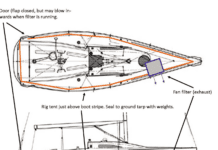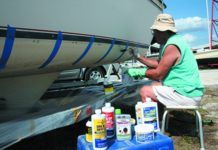Firefighting Options
This past weekend my wife and I witnessed a 25-ft. Bayliner burn to the point that the only thing recognizable on the vessel was the stainless steel bowrail. Fortunately the two persons onboard escaped with only minor injuries.
Several things were surprising about the fire: The intensity of the fire-the Coast Guard could not knock down the flames with their fire hose.
Fiberglass really burns after it gets going. The fire was still burning the next morning 16 hours after the fire started. All attempts by other boaters with dry chemical extinguishers had no effect on the fire.
When I got home Sunday evening, in the mail was Practical Sailor with an article on fire extinguishers (August 15). On Monday I talked with several people with marine firefighting expertise. Below is a list of some of the things I learned and actions I am going to take aboard our 30-ft. sailboat.
There is no silver bullet when it comes to fighting marine fires; early and quick response is your only chance. You must be prepared to abandon the vessel quickly if you cannot control the fire. Taking your advice (August 15), I will purchase a Fire Out Foam Extinguisher. There is now a new Halon-type extinguisher that is EPA-approved. Halotron I is the name of the extinguishing agent.Both of these extinguishers are available from West Marine, and are fairly pricey.
I have a wash-down system I use when retrieving the anchor.I will now leave it connected and the valves open when aboard so that I can use it as a fire hose.I will replace the hose so it can reach any spot on the boat.
In conclusion, I have to admit that I have been negligent in not doing better planning for both a fire and for abandoning ship. Thank you for your timely article.
-Pat Harman, S/V Stormy
Via e-mail
———-
Soak Flares, Discharge Primers
I appreciated the letter from Martha Rose in the August 1, 2001 issue regarding disposal of old flares. As Ms. Rose writes, my local trash collector in Fairfax County, Virginia, will take old flares as long as they have been soaked in water long enough. But this does not completely resolve the disposal question when shotgun shell flares are involved. The flare itself can be disposed of as described. The primer, however, remains as a dangerous explosive which should not be discarded in the trash. I soak each flare long enough to get rid of the gunpowder and then put the empty shell in the gun and shoot it (after warning people nearby that they might hear what sound like gunshots).
-Philip Gallman
McLean, VA
———-
Lexan vs. Acrylic
In the August 15 Mailport, there are comments regarding the relativeattributes of these two plastic sheet products. I spent several years inthe business of selling these two products side by side, and there can be nodoubt that your reader Jim Wills, and also the editors, are exactly wrong indescribing polycarbonate as more scratch resistant than acrylic. Poly ismuch the softer material, and hence scratches much more easily. Impactresistance is vastly superior and light transmittance is marginally reducedcompared to acrylic. UV degradation was a topic for debate back then, having to do with additives in the particular brand/style of sheet product.
-Bruce Epke
Via e-mail
———-
A Range of Broker Types
Your recent boatbuying suggestions (June) were on target in some areas but missed the mark in others. In terms of fair market value, it is unwise for a buyer to place any emphasis on the sometimes grossly inflated asking prices in boat ads. Especially in today’s buyer’s market, where boats are moving slowly, actual recent sales prices or “comps” are the only true indicator.
Your comments on boat brokers touched a chord, and I have my own experience to relate. I’ve encountered several levels of proficiency. Some brokers (I am referring to individual people, not companies) are conscientious, bright, hard-working sailors with business experience and their clients’ best interests at heart. They price the boat accurately for the seller’s benefit to sell within three to six months, and represent a boat’s true condition to a potential buyer. They’re as good as gold and sometimes just as hard to locate. Seek referrals to find them.
Others may be sailors and may even be well-intentioned, but they are simply inept and disorganized at the business end-they forget your name, your needs, don’t return phone calls, forget to fax information-and you receive an incomplete listing riddled with errors or inaccuracies. Their attempts at promoting the boat frequenty fall flat, and they are slow to recommend an adjustment in a shifting market. They price inventory too high to begin with and let the seller dangle for months or even years with naive, unrealistic expectations, even though that hurts everyone, themselves included. In short, they act as an obstacle rather than a facilitator between buyers, sellers, and other brokers.
The remaining brokers behave similarly, but with an added twist-they may sometimes mislead, shade the truth, or misrepresent. Their “mistakes” are calculated, not accidental. Their motive? Anything goes to sell a listing.
One final word: I am amazed that more sellers don’t forgo the onerous “exclusive right to sell” brokerage contract and insist on reserving the right to sell their own boat themselves as a supplement to using a qualified broker. An occasional three-line ad in Soundings is pocket change, and some online ads are free.
With readily available online databases such as Yachtworld (for brokers) and www.boattraderonline.com (for everyone) to rely on, there is a diminishing need for BUCNet, the boat brokers’ exclusive multiple listing service. In truth, many sellers won’t be able to sell their boat themselves, but they would retain some much-needed control and increase their exposure in today’s soft market-and it becomes a great safety net if you ever find yourself stuck with an unprofessional broker.
-Laurance Held
Cape Cod, MA
———-
Hardening of the Soles
Regarding your recent article on deck shoes, one of our crew has a theorythat the rubber soles dry out over time, starting with excellent tractionbut becoming progressively hard and less effective over time. Some of us have compared our experience and think there may be some validity to this idea, even over a relatively short period of a couple of years. Could this be?
-Bob McLaughlin
Via e-mail
That does seem to be true: The rubber gets harder and thus slipperier. Is it just normal aging? Salt? Heat? Rubber authorities, weigh in.
———-
Where Credit Is Due…
To St. Croix Marine Products, Bloomington, MN: “I never appreciated davits until I finally bought a set of St. Croix removable davits from West Marine. To my surprise, installing davits is not intuitive and although I had what may be adequate and detailed instructions from the manufacturer I couldn’t quite puzzle out the installation. When I called the manufacturer in a state of advanced frustration, I was gently instructed in the physics of davits (not intuitive either) and was sent a set of shims by next day delivery. Now installed and functional, the davits are all I had hoped for and my little Zodiac sits snugly suspended. Rather than being set adrift by the manufacturer, St. Croix showed genuine concern and provided the kind of backup that all manufacturers should try to practice.”
-Cecil H. Fox
Little Rock, AR
To Xantrex/Statpower, Arlington, WA and Lamplighter Marine Electronics, Dania, FL: “Last July, while my Hylas 49 was in the yard for a water maker installation, the transient voltage (MOV) protection circuitry of the on-board PROSine 2.5 kw inverter/charger was literally fried by 250 volts of incoming electricity.The problem was traced to a wiring fault in the dockside power outlet. Before its ultimate cremation, the PROSine’s MOV circuit did exactly what it was designed to do-prevent the high voltage surge from damaging other downstream circuits and components.
Lamplighter Marine, the original installer of the inverter, notified Xantrex/Statpower of the inverter’s fate. Xantrex responded immediately, shipping Lamplighter an entire, brand new replacement inverter at no charge. Lamplighter removed the old unit andinstalled the replacement inverter, also at no cost to me. Everything was as good as new within a few days.
By my best estimate, the retail value of the goods and services provided free to me by these two companies is well in excess of $2,000. Given that neither company had any responsibility for the damage to the original unit, I was truly amazed by their level of response. Such total dedication to customer support and satisfaction is exemplary, to say the least.”
-Paul A. Robishaw
Houston, TX





































